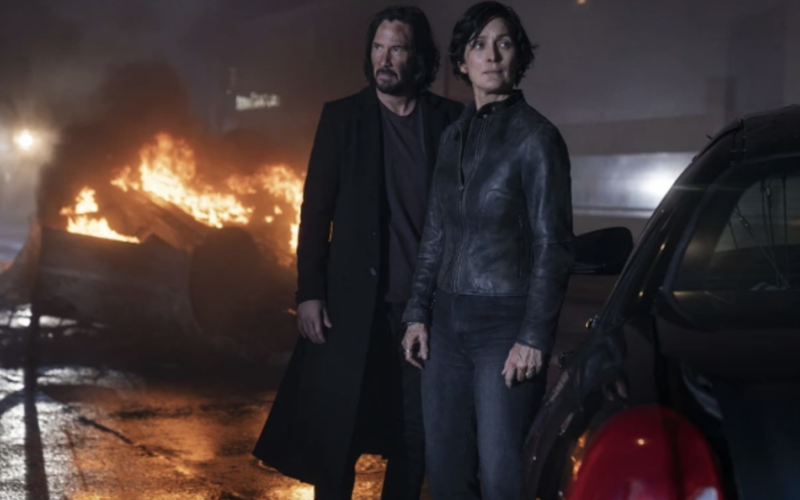BY RICHARD NEWBY | HollywoodReporter.Com
Troy Warren for CNT #Entertainment
All these years later, some viewers are still trying to bend the spoon, instead of accepting that there is no spoon.
[This story contains spoilers for The Matrix Resurrections]
“After all these years, to be going back to where it all started, back to The Matrix.” But the reality is, if there is such a straightforward term within this world, you can’t go back, only forward. Lana Wachowski’s sequel, The Matrix Resurrections, which follows the events established by her and her sister, Lily’s, genre-defining Matrix trilogy, revives the franchise after nearly twenty years. But, like so much of Lana Wachowski’s career, this revival is not one that follows the expected trajectory of a “legacy sequel,” even as the film plays around with nostalgia by very deliberately inserting footage from the original trilogy within its narrative. 1999’s film asked, “What is The Matrix?” and 2021’s The Matrix Resurrections pushes that concept further by asking, “What is it about The Matrix that made you like it in the first place?” Wachowski welcomes division with her latest film, something she’s no stranger to, by sequentially removing many of elements that fans associate with The Matrix in order to reveal what has always been underneath the surface, the source of the franchise: a love story between two humans making the choice to build a better world together.
The Matrix Resurrections welcomes back familiar faces, Neo (Keanu Reeves), Trinity (Carrie-Anne Moss) Niobe (Jada Pinkett-Smith), familiar characters with new faces, Sati (Priyanka Chopra), Smith (Jonathan Groff), Morpheus (Yahya Abdul-Mateen II), and new characters, Bugs (Jessica Henwick), Sequoia (Toby Onwumere), and The Analyst (Neil Patrick Harris), as it navigates a Hollywood film culture dominated by sequels, remakes, reboots, recastings and legacy characters. The Matrix Resurrections will undoubtedly mean many things to many people, at least those savvy and invested enough to engage with it beyond the level of superficial. And, as cleverly set up by the film’s meta-narrative, in which The Matrix Trilogy is a video game created by Thomas Anderson (Reeves) within the Matrix, none of these engagements are wrong. But there are, the film suggests, levels of anti-engagement that hinge more so on what the film is doing aesthetically and literally than what it is doing emotionally. All these years later, some audiences are still trying to bend the spoon, instead of accepting that there is no spoon.
When we meet up with Thomas Anderson, his past life as Neo relegated to dreams that he turned into a best-selling video game, he is deeply unhappy. He’s chasing a new creative endeavor, a game called Binary. But Anderson was meant for more than the constraints of a binary world. And just as Neo in his game is semi-autobiographical, it feels the same in terms of Anderson serving as a semi-autobiographical avatar for Lana Wachowski, who has also rejected the idea of binaries in her personal life as a trans artist. Even though Anderson is stuck in his routine, the non-negotiable assignment from his boss, Smith, to create The Matrix IV, comes as something of a hostage situation. If Anderson doesn’t do it, Smith assures him that their parent company, Warner Bros., will simply make it with someone else. Obviously, the subtext is the text here and those who have followed along with the production history of The Matrix 4, know that the sequel, once prequel, was going to be written and directed without the Wachowskis involvement should the filmmakers have decided not to return. Thus, Anderson, much like Wachowski, is given the choice to see their deeply personal magnum opus handed off to someone else, or to figure out a way back into it. It’s a choice, which as Morpheus says later, that is an illusion because it’s really “no choice at all.”

Anderson has no choice but to return to The Matrix, just as he has no choice to take the red pill and be awakened to the “desert of the real” once more, with Bugs as his white rabbit leading him down the rabbit hole, and Morpheus, this time a program created by Anderson within his video game and given sentience by Bugs, serving as his guide. With this new iteration of Morpheus in particular, Wachowski pokes fun at the way in which reboots, and sequels seek to emulate familiar lines of dialogue by going for a cliff notes version in order to achieve audience recognizability (all the variations on “with great power, there must also come, great responsibility,” immediately springs to mind). Instead of Laurence Fishburne’s gravitas and intrigue, we get Yahya Abdul Mateen II’s “blah, blah, blah,” which both pokes fun at the audience’s expectation to see the same scene again and the fact that so much of that “red pill or blue pill” speech from the original film has been co-opted by right-wingers, and those who don’t have the faintest understanding of what the scene means in the context of the larger story. By way of the internet and the way in which art is commodified into political agendas and memes, those words that once carried such weight have just become noise: blah, blah, blah.
There’s a lot of earned ribbing of the audience when it comes to their expectations for The Matrix sequels, especially when looking at the discourse that still surrounds The Matrix Reloaded (2003) and The Matrix Revolutions (2003), by those who simply wanted more of what they got in the first film. Many of the staff on Anderson’s development team, particularly his co-worker Jude (Andrew Lewis Caldwell) are representative of the kind of fans who rejected the deeper considerations of The Matrix sequels and primarily cared about Kung-Fu, cool gunplay, and the first, and easiest layer of these films, war between humans and machines that can only be ended by the free-will (or is it destiny?) of a Christ-like chosen one. That aspect, Jude and the development team insist, is what players/audiences want from a new Matrix entry. Instead, what Wachowski gives us is something entirely different.
Neo still knows Kung-Fu, but he doesn’t pick up a gun throughout the whole movie, perhaps a response to The Matrix being blamed for school shootings while the lack of laws and regulations are obviously the real culprit. The offensive powers Neo displayed in the previous films are largely defensive, a kind of force-shield, for lack of a better term, that prioritizes protection over destruction. The goal of the film, and of the characters, both human and machine, isn’t to destroy The Matrix or the machines, but to change humanity’s relationship to them. In the 60 years that have passed in the real world between the events of The Matrix Revolutions and The Matrix Resurrections some humans and some machines have come together and learned to co-exist, attaining what the machines tried to achieve during the period known as The Second Renaissance and showcased in The Animatrix (2003).
They are stronger together, and evidenced by the city Io, built from the remains on Zion in both physical structure and alphabet. Not only does Io reflect the 1s and 0s that make up code, but it is also a reversal of 01, the first Machine City that led humans to set off their nuclear weapons. Io suggests that humans and machines have the capability to be harmonious and express individualism. This point of harmony is underscored by Resurrections’ central element, the love story between Neo and Trinity, which ultimately forces the audience to reconsider the mythology surrounding The One.

Following The Matrix Revolutions, Neo and Trinity’s bodies were kept in Machine City and reconstructed once it was discovered that together they formed a powerful source of energy, their charge representing the quality that guides all human life, the hope of holding onto what you have and achieving more, and the fear of losing it – positive and negative, 1 and 0, I and O, again. That hope and fear was the defining factor of every choice Neo and Trinity made in The Matrix trilogy, which, given human nature, was really no choice at all. Just as humans cannot thrive without the benefit of machines, Neo cannot thrive without Trinity, and his powers are limited without her presence. Thus, once awakened back in the real world, Neo can only save himself by saving Trinity, who is trapped in The Matrix as a wife and mother of two named Tiffany. This is an earnest approach to love that we don’t see often enough in contemporary blockbusters. It’s the transcendental power of love that makes Neo who he is, and his powers within the Matrix are guided by feelings rather than fact.
The final act, both the rescue of Trinity in the real world, and Thomas and Tiffany’s motorcycle chase from The Analyst’s Swarm Bots, are based around escape, which plays out so differently from The Matrix’s final act of confrontation, that it is jarring, intentionally so. The big fight here is not Neo versus Smith, but Neo and Trinity’s fight to reunite. And in the end, it’s not a belief in The One that saves them but a belief in the two of them — a binary relationship formed out of escaping the parameters of a binary world. When Neo and Trinity jump off the building, escaping the bots, Trinity flies and catches Neo. With this act we realize that Neo was never The One alone, he was because of Trinity, who becomes fully aware of her own powers within the Matrix by the end of this film. The original film ended with Neo flying off, a superhero within the world of the Matrix, with the course set for a battle of good against evil, right before superhero films would become our most popular means of entertainment. In the end of The Matrix Resurrections, Neo and Trinity take control of the Matrix from The Analyst and set out to remake it. What that means for the minds inside of it, those there willingly and those held captive, remains to be seen, hopefully in further installments.
Neo and Trinity don’t settle for being something as common as superheroes in a battle against good and evil. They set out to remake the world as digital gods, which in turn is the freedom Lana Wachowski has rediscovered with this very film: the choice to rebuild this franchise in her own image, and whether we come along willingly or are simply captive to our desires for sequels and content, there’s the promise that whatever is built will be unlike anything we’ve experienced before.
In Other NEWS



































